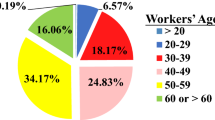Abstract.
Objectives: During the period of technological innovation and rapid economic development, portable power tools were introduced on a large scale in Japan. Vibration disease from the operation of those tools and its prevention and therapy became urgent social problems in the 1970s. This paper aims to introduce national regulations in Japan for diagnostics in the health surveillance, certification, therapy and compensation of vibration disease and evaluates them in the present perspective. Method: Relevant laws, regulations and administrative directives were described in chronological order. Effect of those laws, regulations and directives were evaluated by statistics. Results: Relevant regulations were established in 1947 and were revised in the 1960s and 1970s. According to those regulations, administrative directives were issued. Relevant vibration-disease statistics improved from the 1970s to 1990s. The annual ratio of workers examined was 95% to 100% in national forests (NFs), 47.3% in 1980 and 40.8% in 1990 in private industry (PI). The number of workers certified in NFs was 1,796 from 1971–1975, with a decrease to nine from 1991–1995, while in PI there were 9,783 from 1976–1980, decreasing to 2,331 from 1991–1995. However, in the construction industry the number increased again in the 1990s. The top four workers certified by the type of tool from 1994–1997 were operators of rock drills, chainsaws, pick hammers and concrete vibrators. The annual number of workers under treatment (at highest level) was 3,605 (1982; NFs) and 13,501 (1987; PI), with a decrease to 3,481 (1997; NFs) and 8,958 (1997; PI). Regulations for compensation covered 3,670 workers from1965 to 1997 (NFs) and 22,723 from 1976 to 1997 (PI) in medical treatment benefits, and 189 (NFs) and 15,448 (PI) in disability benefits during the same term. Conclusion: The national regulations developed in Japan since 1965 for health surveillance, certification, therapy and compensation of hand-transmitted vibration disease have proven effective for prevention and compensation of vibration disease in many industries, but unsolved problems remain in the construction industry.
Similar content being viewed by others
Author information
Authors and Affiliations
Additional information
Electronic Publication
Rights and permissions
About this article
Cite this article
Yamada, S. National regulations for diagnostics in health surveillance, therapy and compensation of hand-transmitted vibration injury in Japan. IAOEH 75, 120–128 (2002). https://doi.org/10.1007/s004200100286
Received:
Accepted:
Issue Date:
DOI: https://doi.org/10.1007/s004200100286




